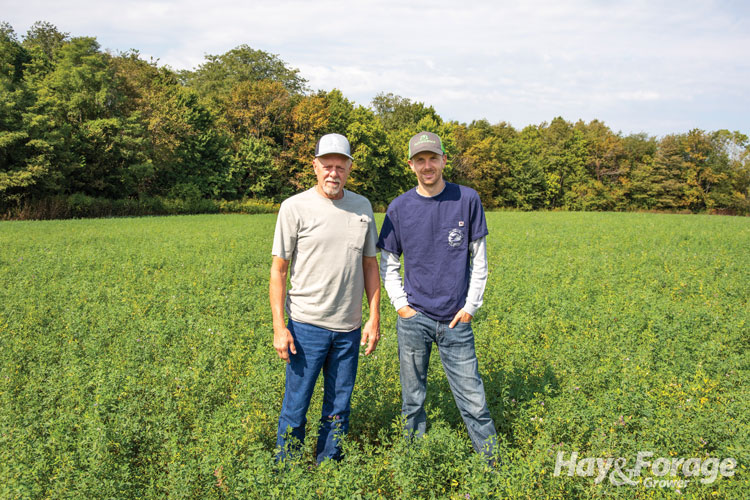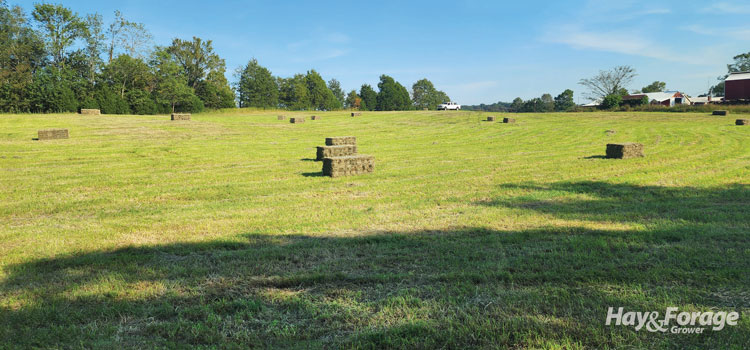
Don’t tell Keith (left) and Ellis Deweese that you can’t start a successful hay business. Their small but growing Kentucky hay farm caters to horse owners and stables.
Keith Deweese wasn’t different from a lot of people who liked to farm but didn’t have the acres or the resources to make it a full-time occupation. He carved out his career with the postal service and raised beef cattle as a side hustle on the small family farm near La Center, Ky. During those years, the third-generation farmer’s haymaking was hired out or he simply purchased what feed was needed.
“It got tough to make money, so in 2012 I sold the cows, retired as a postmaster, and rented my land out for row cropping,” the amiable Keith explained. “That lasted for four years. Then, when one of my neighbors decided to retire and get out of the hay business, I decided to buy his used equipment and try my luck at making hay, starting out on a small scale.”
To be clear, this isn’t the story of a small hay producer that grew and is now shipping hundreds of semitrailer loads of hay per year. This is one documenting the front end of such a journey, wherever it may lead. It’s a story of getting started in the hay industry, smattered with both successes and challenges, but mostly the former.
Keith knows horse people; he is one. Both Keith and his wife, Jimmilyn, own horses and participate in rodeo events such as team roping (Keith) and barrel racing (Jimmilyn). Keith knew the equine market was primed with people wanting high-quality grass hay and willing to pay for it. He felt making hay was a worthy gamble, and he had time to do it.
Ellis Deweese is the middle of three sons that Keith and Jimmilyn raised. A diesel mechanic by training, Ellis also has held jobs at the postal service and as an information technology (IT) specialist. The latter job required on-call hours throughout the day and night. “After several years, I just got burned out from the hours and travel, so I joined my dad in the hay business,” Ellis said. That was 2019, and Deweese Hay Emporium was born to the father-son partnership. Ellis’s wife, Jamie, is a paralegal at a law firm but also provides valuable assistance on the farm.
At the time Ellis entered the haymaking fray, the farm was only producing about 2,500 small square bales per year. These days, the farm consists of about 140 owned and rented hay acres split between 81 acres of alfalfa, 43 acres of timothy, and 16 acres of orchardgrass. This past year, about 60 acres of straw was also baled off a neighbor’s fields. During Ellis’s tenure, the haymaking duo has added acreage and boosted total production to nearly 15,000 bales. They continue in a manageable growth mode.
Marketing matters
Since his foray into the hay business, Ellis has led the marketing charge. Marketing approaches and philosophies have evolved over time. “We actually sell more hay than we make,” Ellis said. “Each year, I usually have to source some additional hay from people I’ve developed relationships with.”
For most of the past four years, the Deweeses were satisfied selling hay in smaller lots, delivering if the distance wasn’t too far. “We used to advertise and used Facebook extensively to sell hay, and that was really successful,” Ellis explained. “Today, most of our hay goes to three different horse stables in Tennessee. They call every month when hay is needed, and I truck it down to them using our pickup and flatbed gooseneck trailer. They all have the equipment to unload the hay. The Tennessee hay market has exploded around Nashville with people moving in from the West,” he added.
It’s a well-known fact in the hay industry that most horse owners don’t have much use for hay test results, but that’s not the case for the Deweeses’ primary clients. “They’re pretty educated and want to see the forage analysis on every load I deliver,” Ellis said. “That doesn’t leave us much room for error. It’s not just a hay color game for us.” Keith added, “We test everything we bale and buy.”
Ellis, like most good hay marketers, learned early and emphasized the importance of being honest about the hay product being sold. That’s easier when you have a forage analysis in hand. For him, a bigger marketing challenge and frustration has been delivering hay to horse owners who don’t have the equipment to unload bales. That’s one reason why he’s getting away from deliveries of smaller lots or has tried to ensure unloading won’t be a problem. They still welcome clients who will come to their farm and pick up their bales.
A complete menu
Knowing the disparate nature of hay requests by horse owners, the Deweeses have attempted to diversify their forage acreage. Alfalfa is their primary hay product, but they also offer pure timothy or orchardgrass hay and have grown teff grass from time to time. With a rising demand for alfalfa-grass mixtures, they plan to start interseeding orchardgrass into some of their older alfalfa stands.
“In the past, we’ve broadcasted alfalfa seed to establish a stand, and we’ve had pretty good success doing that both in the spring and fall,” Keith said. “Of course, you have to have a good seedbed. I usually broadcast a half rate going opposite directions in the field, then we roll the field a couple of times.”
Keith noted that they’ve recently started to no-till alfalfa into spray-killed grass stands. “That was pretty successful, too,” he said. The Deweeses seed alfalfa at a rate of 20 to 25 pounds per acre of seed (33% coating). Recently, they have been using some varieties with the HarvXtra trait. They usually keep an alfalfa stand for three to five years.
As for their grass production, timothy fields generally only yield one cutting; they simply go dormant in the heat of a Kentucky summer. Ellis said they’ve had the best luck with the Richmond variety, which often offers three years of production. “We’ve tried and continue to try other varieties, but nothing so far has matched Richmond for its persistence,” he explained. “The demand for our timothy hay is pretty strong, so we want to continue to grow it.”
Orchardgrass is what Keith prefers to feed his own horses, and there’s also a good demand from other horse owners. “We get three cuttings of orchardgrass each year,” Keith said. “We’ve been using the HLR variety from Barenbrug. It’s really leafy.”

Timing is everything
“We try our best to get five cuttings of alfalfa and stay on a 28- to 33-day cutting interval,” Keith said. “Of course, there are some years like 2023 where we were lucky to get a day when it didn’t rain early in the season.” Ellis added, “Timing is everything when you’re trying to make horse-quality hay.”
The Deweeses cut their hay with a 9.5-foot Massey Ferguson disc mower, laying the swath out wide. If the humidity is high with a short window for baling, they will ted alfalfa behind the cutter. If not, the tedding step is skipped, except for grass hay, which is always tedded. Raking is done with an Enrossi rotary rake. “I wouldn’t use anything else for alfalfa,” Keith said of his experience with the rotary rake.
Once dry, the hay is baled with a Massey Ferguson 1840 in-line baler. All of their alfalfa is treated with a propionic acid preservative, and that hasn’t been a concern for their horse-owning customers. “We shoot for a 55- to 60-pound alfalfa bale and a 50- to 55-pound grass bale,” Ellis noted. “Most of the people we deal with are women, and they don’t want an 80-pound bale.”
Bales are dropped on the ground off the baler and then picked up with a new Arcusin E14 accumulator. The accumulator compresses and ties the bales into 14-bale bundles (two bales by seven bales). “We like the Arcusin because it has a compact design, which works well in our smaller fields,” Ellis said. “It is also pretty forgiving on bale length.”
The bale bundles are picked up and loaded using Steffen grapples. Hay is stored in one of three barns, two of which are rented. Ellis said they typically line the ground with plastic and put down pallets to preserve the integrity of the bottom layer of bales. One thing that aids the father-son duo during crunch haymaking times is that they sometimes work together with a neighbor and share labor and machinery.
A bright future
Although the Deweeses’ venture into hay farming has been relatively short to this point, they’ve already built a workable system and a reliable client base that is actually larger than their current production capabilities. Like nearly all haymakers, they are mostly challenged by weather.
As for the days ahead, Ellis said they’d like to keep growing. “We’re in a predominantly row-cropping area, so land prices and rental rates aren’t cheap,” the young farmer noted. “I’d like to latch on to some larger fields, which can be farmed more efficiently. We’ll keep looking.”
This is not the end of the Deweese Hay Emporium story. In fact, it’s just getting started. •
This article appeared in the January 2024 issue of Hay & Forage Grower on pages 6-7.
Not a subscriber? Click to get the print magazine.

